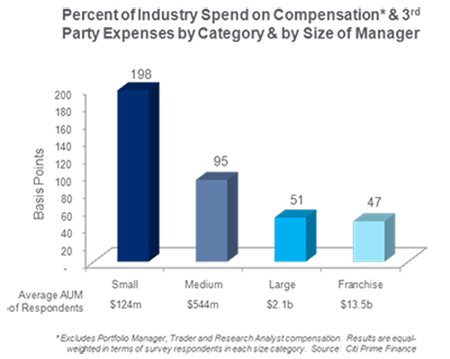(December 12, 2012) — It takes at least $250 million in assets for a hedge fund to be self-sustaining on its management fees alone, according to a survey by Citi Prime Finance.
The study determined that managers need between $250 million and $375 million in assets under management to break even and survive off management fees alone. These firms rely heavily on third parties for key business functions, the study said, noting that the largest hedge funds incur significant additional costs due to complexity and size.
This is the first global survey of the costs of establishing and managing a hedge fund business. It’s goal: to shed light on business expenses involved in running a hedge fund, and to provide benchmarks for hedge fund executives as well as for investors conducting due diligence into how managers run their organizations.
“The cost of running an operationally sustainable hedge fund is substantial,” said Alan Pace, global head of sales and client experience for Citi Prime Finance, in a statement. “Hedge fund management firms of all sizes and lifecycle stages need to pay close attention to business expenses to the benefit of their firms and their investors.”
Sandy Kaul, US head of business advisory services for Citi Prime Finance, added: “This ground-breaking survey shows that smaller managers with assets under $250 million, which represent some 80% of all hedge funds and a quarter of total industry assets, are hard pressed to survive on management fees alone without capital injections from partners or incentive fees. At the same time, the very largest managers, about 1 percent of the hedge fund universe controlling some 60% of total industry assets, face steep costs due to diversified and complex portfolios.”
Read Citi’s full study here.Citi’s paper follows an October study from financial software provider PerTrac, which showed that small hedge funds have a leg up compared to their larger rivals when it comes to long-term performance. It also discovered that during down markets the outlook for small funds is not as rosy.
“When you look at small funds, they’re generally younger. They’re trying to build up track records and they’re more likely to take risk,” Jed Alpert, PerTrac’s managing director of global marketing, told aiCIO at the time. “We see that smaller hedge funds also tend to have higher volatility.”
Related article: The Large vs. Small Hedge Fund Battle

